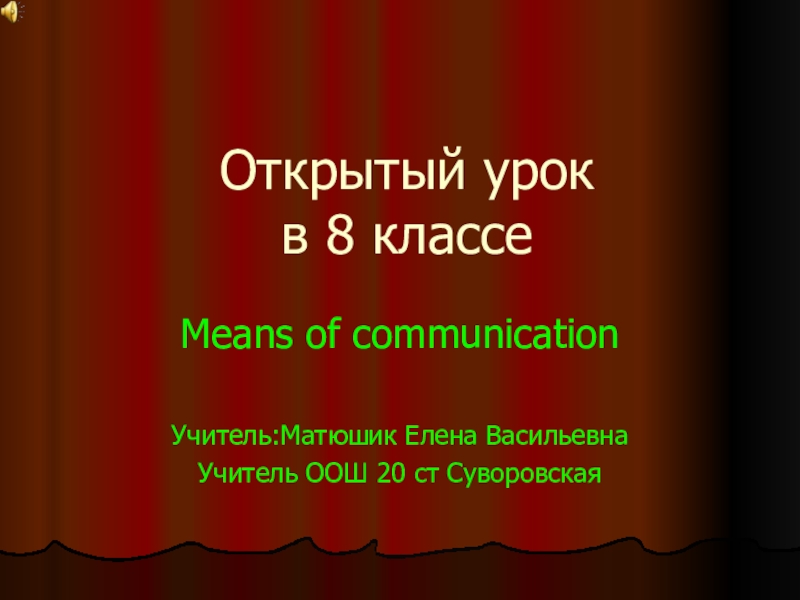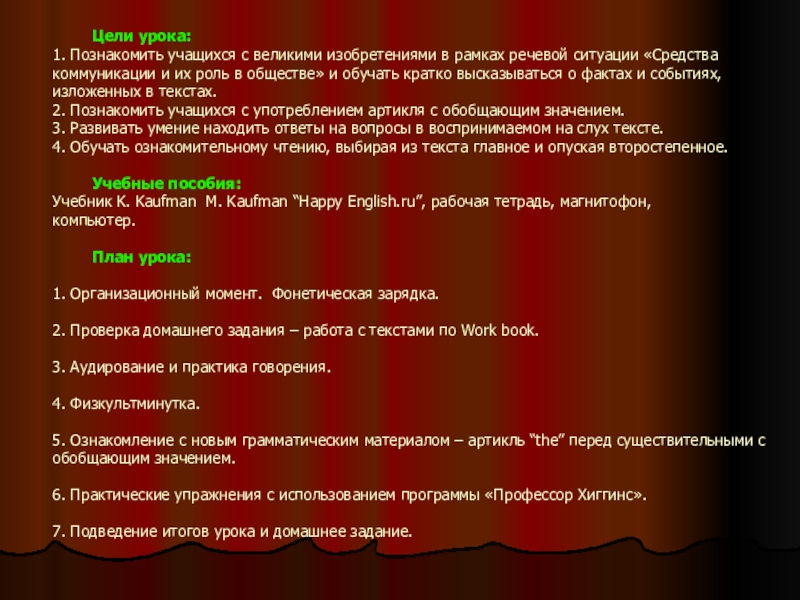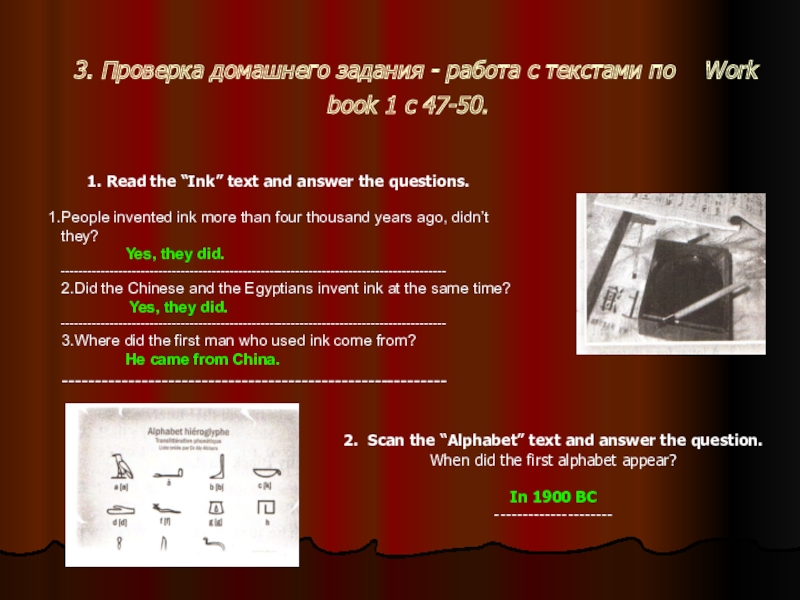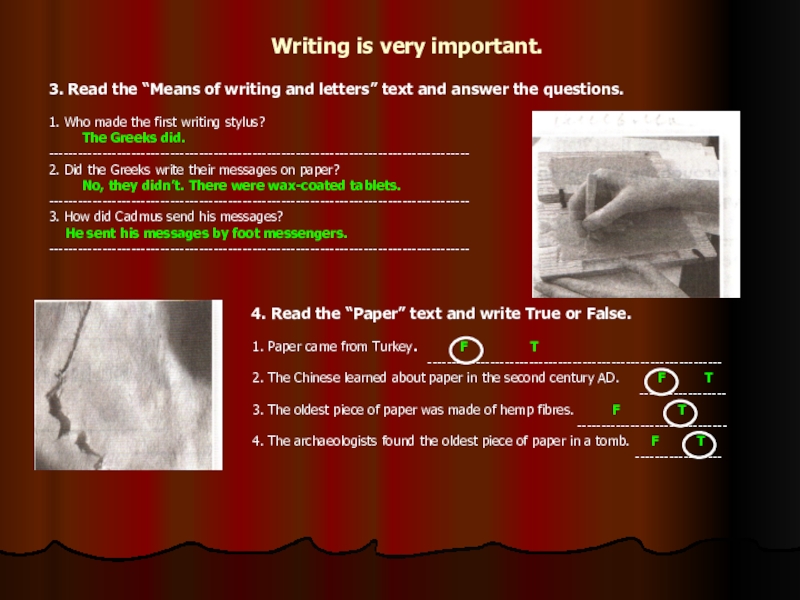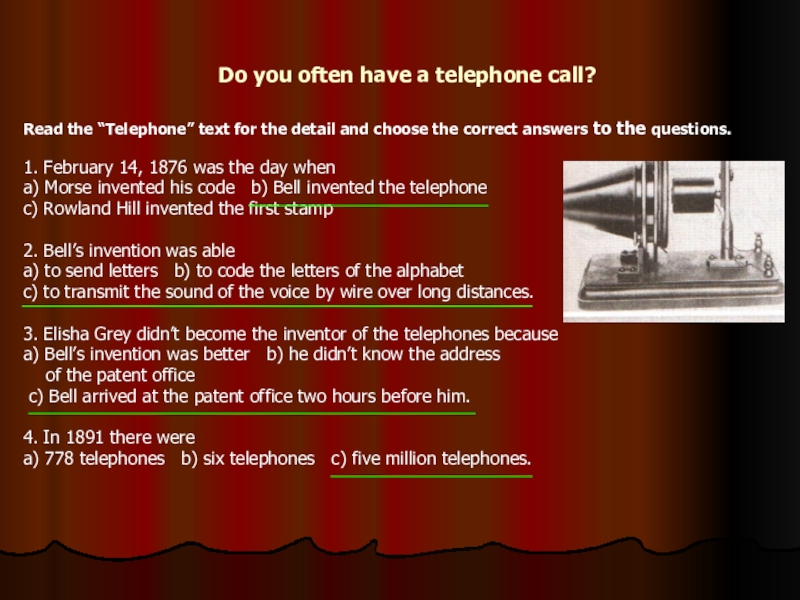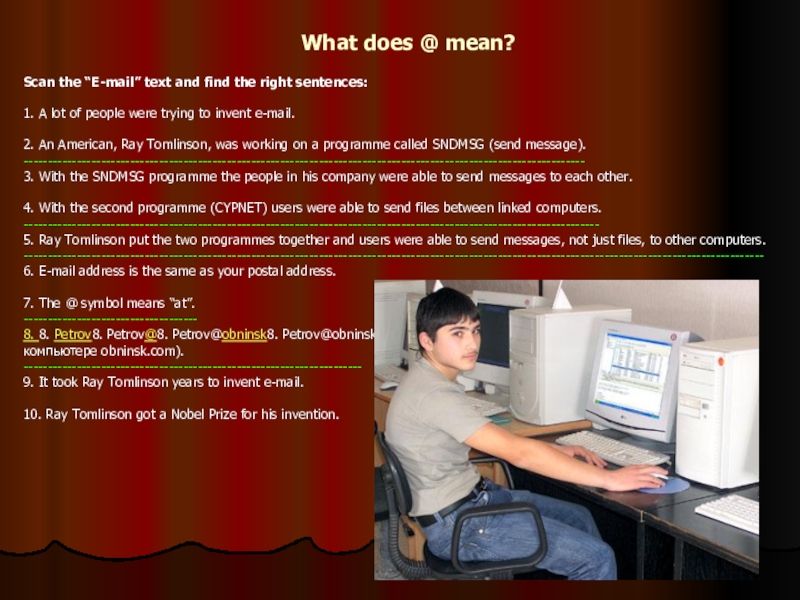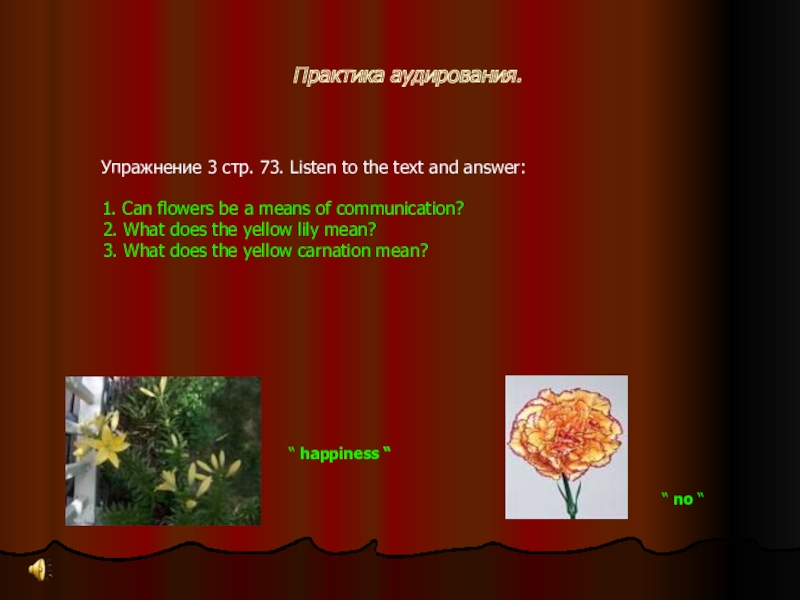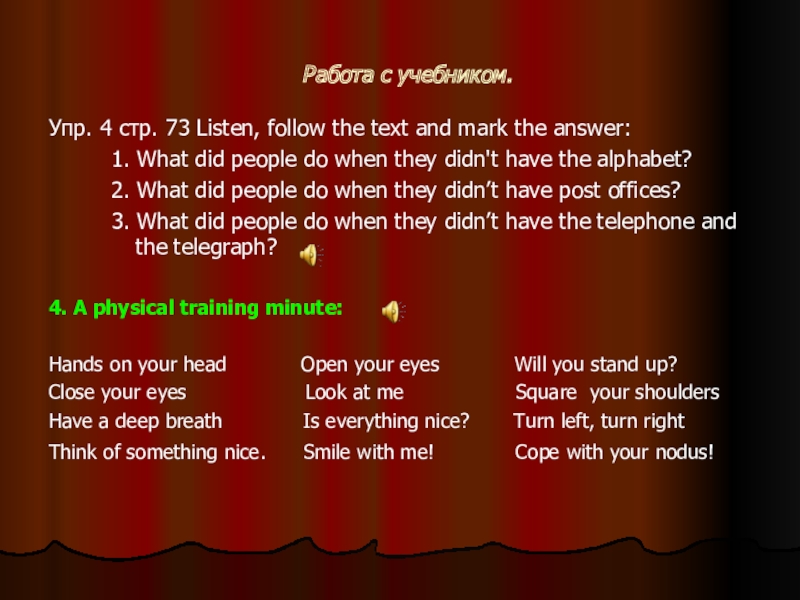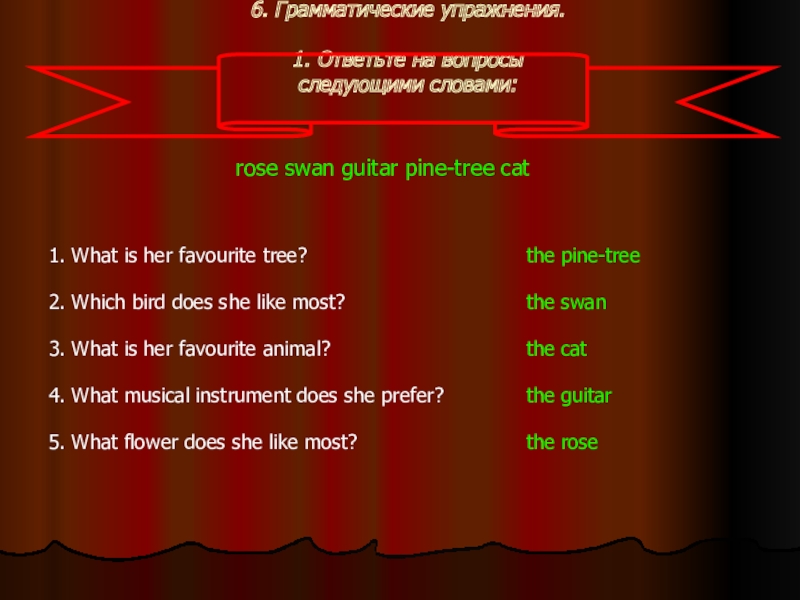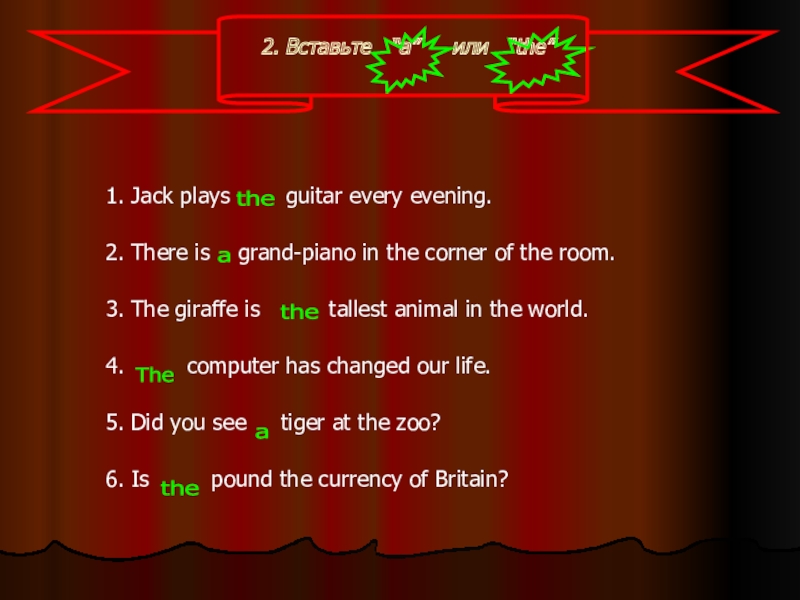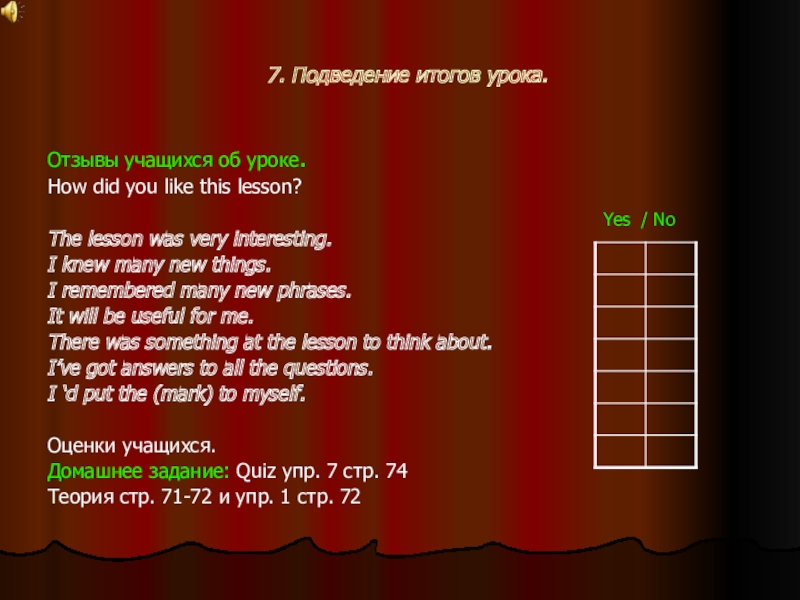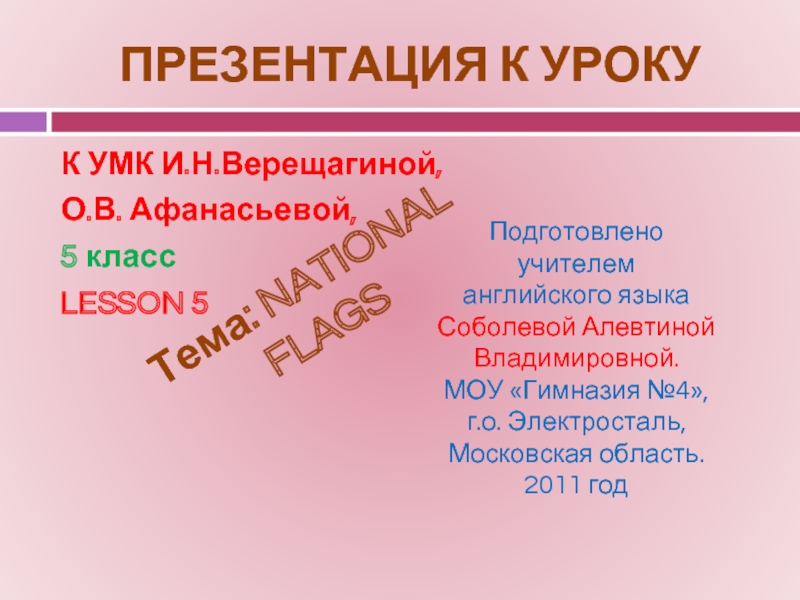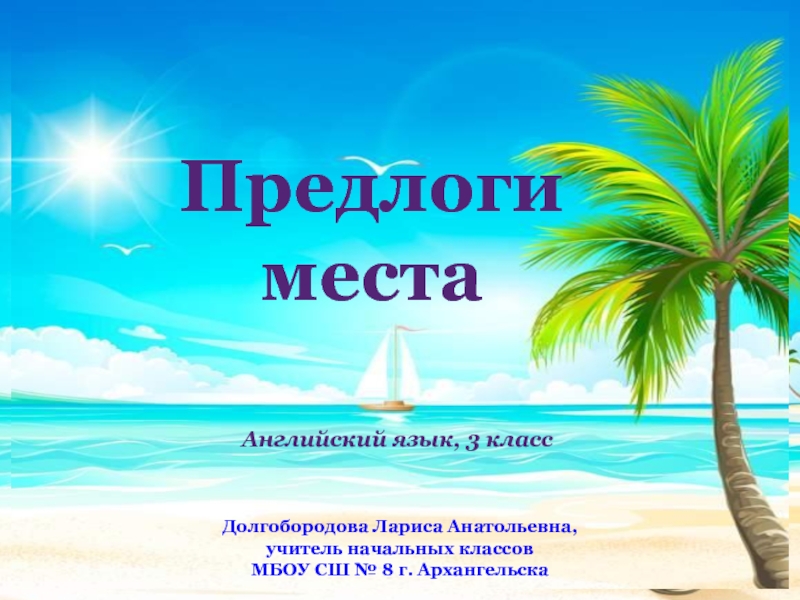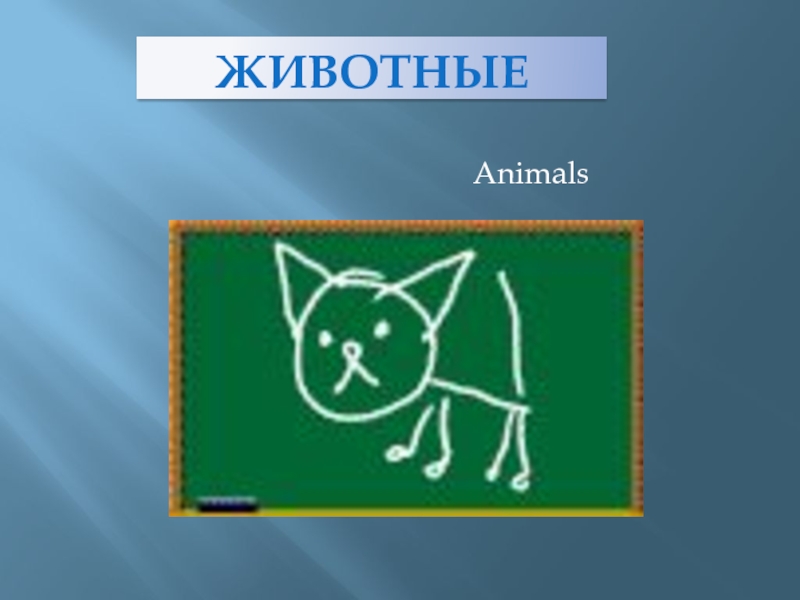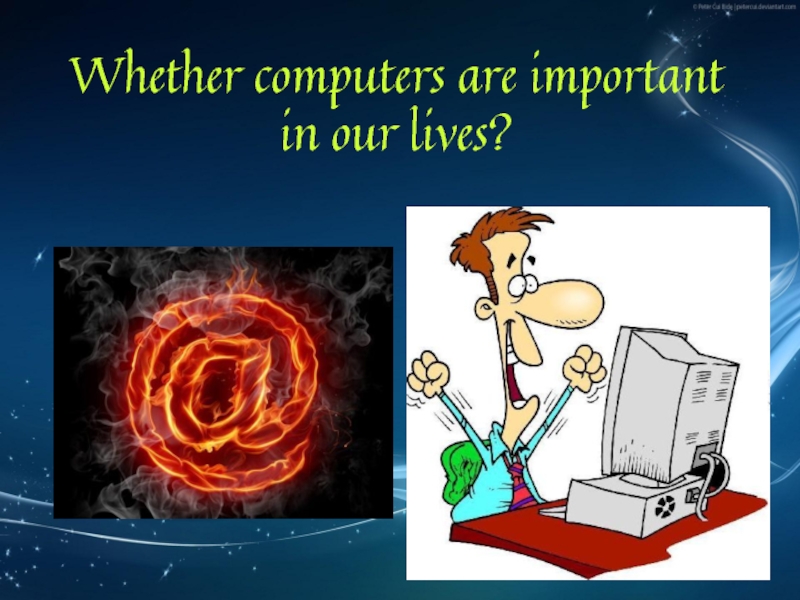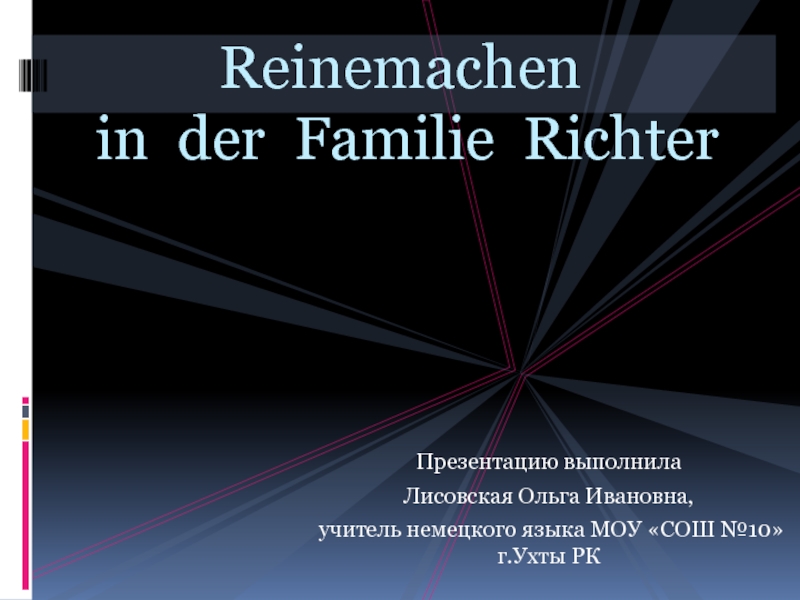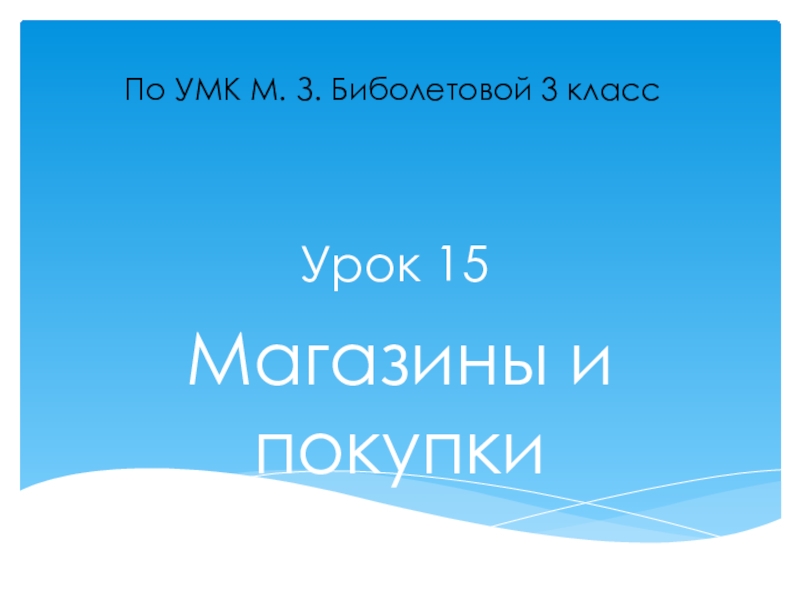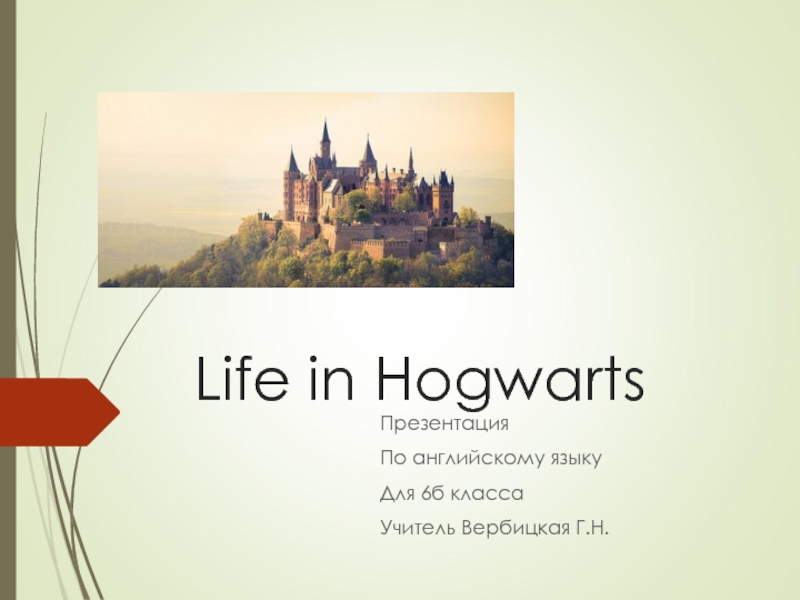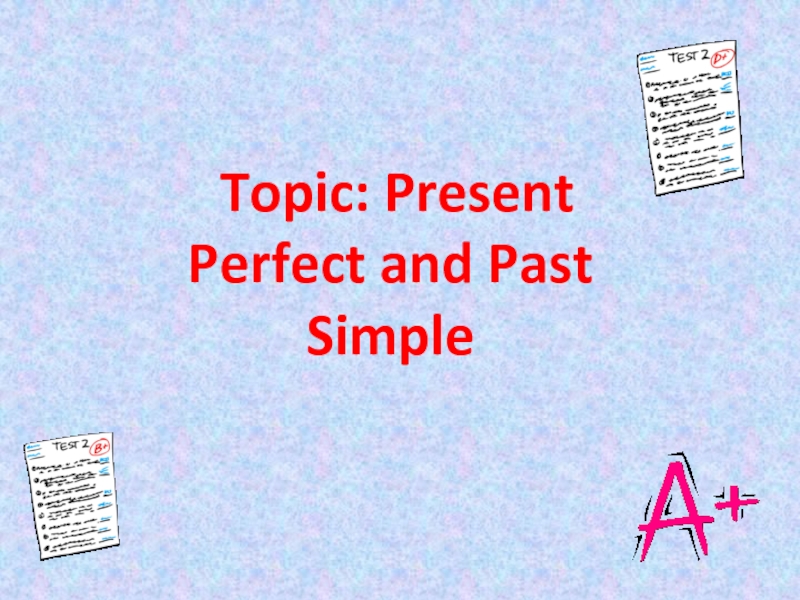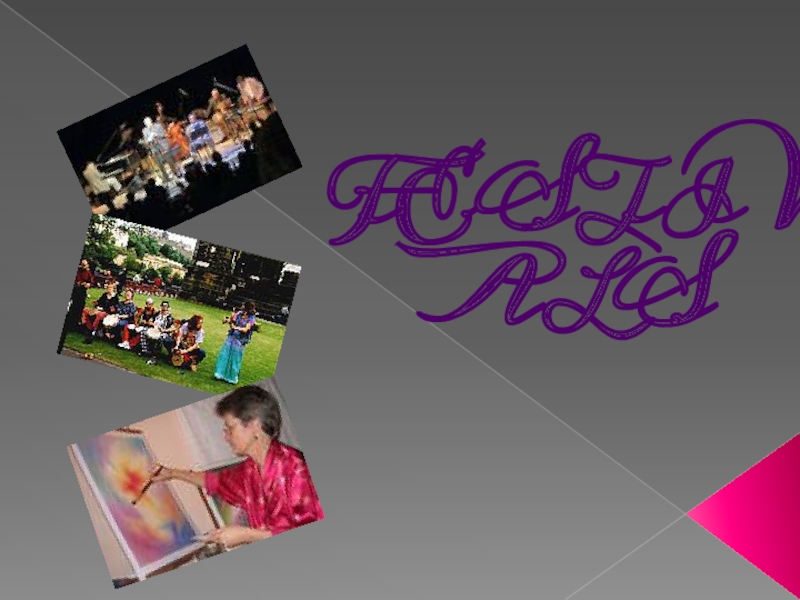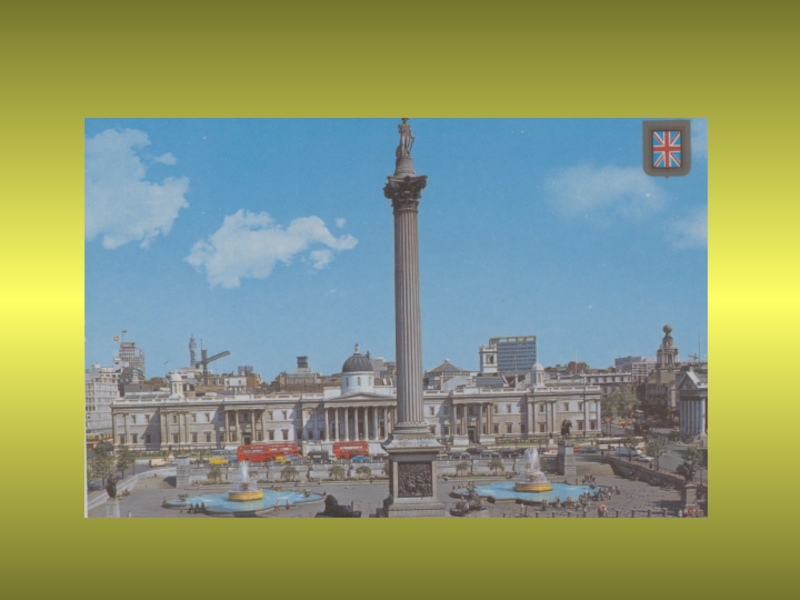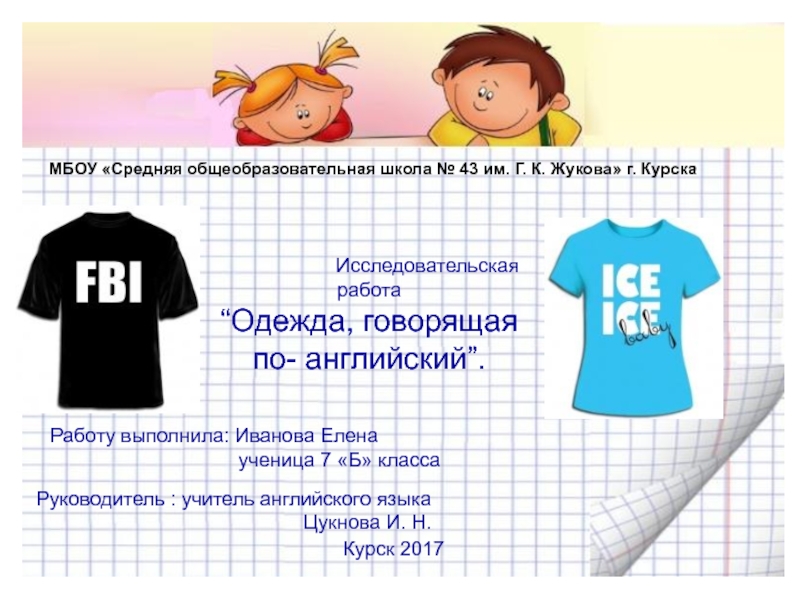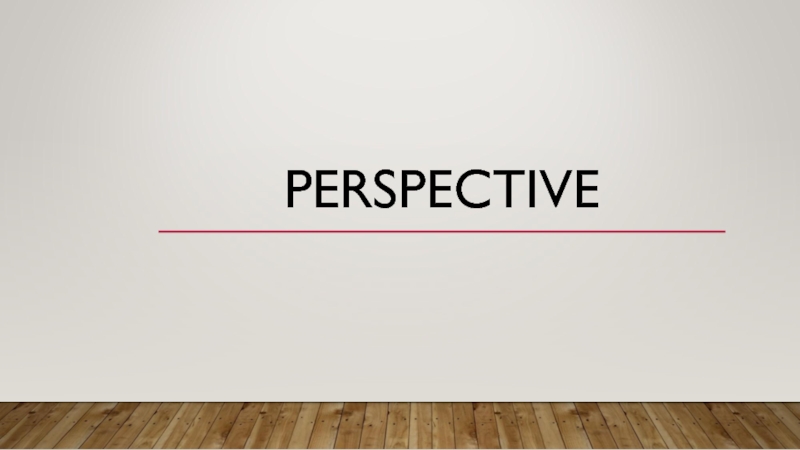Разделы презентаций
- Разное
- Английский язык
- Астрономия
- Алгебра
- Биология
- География
- Геометрия
- Детские презентации
- Информатика
- История
- Литература
- Математика
- Медицина
- Менеджмент
- Музыка
- МХК
- Немецкий язык
- ОБЖ
- Обществознание
- Окружающий мир
- Педагогика
- Русский язык
- Технология
- Физика
- Философия
- Химия
- Шаблоны, картинки для презентаций
- Экология
- Экономика
- Юриспруденция
Средства общения
Содержание
- 1. Средства общения
- 2. Цели урока: 1. Познакомить
- 3. Слайд 3
- 4. 3. Проверка домашнего задания - работа
- 5. Writing is very important.3. Read the “Means
- 6. 5. Read the “Penny Black” text
- 7. Do you often have a telephone call?Read
- 8. What does @ mean?Scan the “E-mail” text
- 9. Упражнение
- 10. 1.Which of these things can you call
- 11. Quiz. 1.Who invented paper?the
- 12. Работа с учебником.Упр. 4 стр. 73 Listen,
- 13. 5. Артикль “the” перед существительными с обобщающим
- 14. Артикль “the” с прилагательными.Помните, что эти слова
- 15. 6. Грамматические упражнения. 1. Ответьте на
- 16. 2. Вставьте “a” или
- 17. 3. Дополните предложения, употребляя прилагательные:
- 18. 4. Какая у них национальность? Britain? Germany?Japan?Canada?America?Italy?France?Greece?the Britishthe Germansthe Japanesethe Canadiansthe Americansthe Italiansthe Frenchthe Greeks
- 19. 7. Подведение итогов урока.Отзывы учащихся об уроке.
- 20. Скачать презентанцию
Слайды и текст этой презентации
Слайд 1Открытый урок
в 8 классе
Means of communication
Учитель:Матюшик Елена Васильевна
Учитель ООШ
20 ст Суворовская
Слайд 2 Цели урока: 1. Познакомить учащихся с великими изобретениями
в рамках речевой ситуации «Средства коммуникации и их роль в
обществе» и обучать кратко высказываться о фактах и событиях, изложенных в текстах. 2. Познакомить учащихся с употреблением артикля с обобщающим значением. 3. Развивать умение находить ответы на вопросы в воспринимаемом на слух тексте. 4. Обучать ознакомительному чтению, выбирая из текста главное и опуская второстепенное. Учебные пособия: Учебник K. Kaufman M. Kaufman “Happy English.ru”, рабочая тетрадь, магнитофон, компьютер. План урока: 1. Организационный момент. Фонетическая зарядка. 2. Проверка домашнего задания – работа с текстами по Work book. 3. Аудирование и практика говорения. 4. Физкультминутка. 5. Ознакомление с новым грамматическим материалом – артикль “the” перед существительными с обобщающим значением. 6. Практические упражнения с использованием программы «Профессор Хиггинс». 7. Подведение итогов урока и домашнее задание.Слайд 3 1. Организационный момент. Рапорт
дежурного. Задания к уроку.
2. Фонетическая зарядка по материалу домашнего задания.
[reI
‘tOmlInsqn]Ray Tomlinson
[‘IlISq greI]
Elisha Gray
[‘grxm bel]
Graham Bell
[‘sxmjuql mO:s]
Samuel Morse
[‘roulqnd hIl]
Roland Hill
[‘faIbqz]
fibres
[‘kxdmqs]
Cadmus
[wxks]
wax
[I‘dZIpSqnz]
the Egyptians
[‘IdZIpt]
Egypt
[CaI‘nJz]
the Chinese
Слайд 4 3. Проверка домашнего задания - работа с текстами по
Work book 1 с 47-50.
People invented ink more than four thousand years ago, didn’t they?
Yes, they did.
---------------------------------------------------------------------------------------
2.Did the Chinese and the Egyptians invent ink at the same time?
Yes, they did.
---------------------------------------------------------------------------------------
3.Where did the first man who used ink come from?
He came from China.
----------------------------------------------------------
1. Read the “Ink” text and answer the questions.
2. Scan the “Alphabet” text and answer the question.
When did the first alphabet appear?
In 1900 BC
---------------------
Слайд 5Writing is very important.
3. Read the “Means of writing and
letters” text and answer the questions.
1. Who made the first writing stylus?
The Greeks did.
---------------------------------------------------------------------------------------
2. Did the Greeks write their messages on paper?
No, they didn’t. There were wax-coated tablets.
---------------------------------------------------------------------------------------
3. How did Cadmus send his messages?
He sent his messages by foot messengers.
---------------------------------------------------------------------------------------
4. Read the “Paper” text and write True or False.
1. Paper came from Turkey. F T
-------------------------------------------------------------
2. The Chinese learned about paper in the second century AD. F T
------------------
3. The oldest piece of paper was made of hemp fibres. F T
-------------------------------
4. The archaeologists found the oldest piece of paper in a tomb. F T
------------------
Слайд 6 5. Read the “Penny Black” text and choose the
correct answers to the questions.
1. Very few people in England were able to send and to receive letters because
a) they couldn’t read b) they had no ink c) they had to pay a lot of money for the letters.
-----------------------------------------------------------
2. Who had to pay for the letters?
a) the people who sent them b) the people who received them c) the postman.
------------------------------------------
3. A letter for a distance of nine miles cost
a) four pence b) five pence c) six pence
----------------
4. The main ideas of Sir Rowland Hill were
a) everybody should send letters b) everybody should be able to send letters c) everybody should pay for the letters.
-----------------------------------------------------
5. The first stamp was called the Penny Black because
a) Penny Black invented it b) there is a picture of Penny Black on it c) it cost one penny and was blaсk.
-------------------------------------------
6. Look through the “Telegraph” text and answer the questions:
What does the word “telegraph” mean?
It means “to write far”
Does the telegraph transmit signals?
Yes, it does.
Who invented the electronic alphabet?
Samuel Morse did.
What was it possible to do with the help of Morse code?
It was possible to code the letters and signs of a language.
Which two cities did the first telegraph connect?
It connected Washington and Baltimore.
Слайд 7Do you often have a telephone call?
Read the “Telephone” text
for the detail and choose the correct answers to the
questions.1. February 14, 1876 was the day when
a) Morse invented his code b) Bell invented the telephone
c) Rowland Hill invented the first stamp
2. Bell’s invention was able
a) to send letters b) to code the letters of the alphabet
c) to transmit the sound of the voice by wire over long distances.
3. Elisha Grey didn’t become the inventor of the telephones because
a) Bell’s invention was better b) he didn’t know the address
of the patent office
c) Bell arrived at the patent office two hours before him.
4. In 1891 there were
a) 778 telephones b) six telephones c) five million telephones.
Слайд 8What does @ mean?
Scan the “E-mail” text and find the
right sentences:
1. A lot of people were trying to invent
e-mail.2. An American, Ray Tomlinson, was working on a programme called SNDMSG (send message).
--------------------------------------------------------------------------------------------------------------------
3. With the SNDMSG programme the people in his company were able to send messages to each other.
4. With the second programme (CYPNET) users were able to send files between linked computers.
-----------------------------------------------------------------------------------------------------------------------
5. Ray Tomlinson put the two programmes together and users were able to send messages, not just files, to other computers.
---------------------------------------------------------------------------------------------------------------------------------------------------------
6. E-mail address is the same as your postal address.
7. The @ symbol means “at”.
------------------------------------
8. 8. Petrov8. Petrov@8. Petrov@obninsk8. Petrov@obninsk.8. Petrov@obninsk.com means (пользователь Петров на
компьютере obninsk.com).
----------------------------------------------------------------------
9. It took Ray Tomlinson years to invent e-mail.
10. Ray Tomlinson got a Nobel Prize for his invention.
Слайд 9
Упражнение 3 стр.
73. Listen to the text and answer:
1. Can flowers be a means of communication?2. What does the yellow lily mean?
3. What does the yellow carnation mean?
“ happiness “
Практика аудирования.
“ no “
Слайд 101.Which of these things can you call a means of
communication? 2. How can you use them to communicate? 3. Which of
these means of communication do you take for granted?Слайд 11Quiz.
1.Who invented paper?
the Chinese b) the
Japanese c) the English
2. Who invented
the alphabet?the Jews b) the Greeks c) the Egyptians
3. Who invented ink?
the Egyptians and the Chinese b) the Chinese c) the Arabs
4.Who first sent private letters from one person to another?
the Greeks b) the Egyptians c) the Romans
5. Who invented the stamp?
the English b) the Russians c) the Americans
6. Who invented the telephone?
Telephone b) Popov c) Alexander Graham Bell
7. Who invented the telegraph?
Alexander Graham Bell b) Samuel Morse c) Mary Telegraph
8. Who invented the e-mail?
a) the Americans b) the Russians c) the Germans
Слайд 12Работа с учебником.
Упр. 4 стр. 73 Listen, follow the text
and mark the answer:
1. What
did people do when they didn't have the alphabet?2. What did people do when they didn’t have post offices?
3. What did people do when they didn’t have the telephone and the telegraph?
4. A physical training minute:
Hands on your head Open your eyes Will you stand up?
Close your eyes Look at me Square your shoulders
Have a deep breath Is everything nice? Turn left, turn right
Think of something nice. Smile with me! Cope with your nodus!
Слайд 135. Артикль “the” перед существительными с обобщающим значением.
1. Часто the
употребляется для обозначения предмета вообще (тип растения, животного и т.д.),
не конкретного предмета.- The tulip is my favourite flower.
- The elephant is the biggest of all animals.
Здесь the tulip употребляется для обозначения целого класса тюльпанов,
также как the elephant употребляется для обозначения целого класса слонов.
2. Существительное во множественном числе употребляется без the
- Tulips are my favourite flowers.
- Elephants are the biggest of all animals.
3. The также употребляется, когда мы говорим о виде машины, изобретения,
о музыкальных инструментах и т.д.
- When was the bicycle invented?
- The telephone is used for communication.
- My son likes to play the guitar.
- Can your daughter play the piаno?
4. The + прилагательное
The употребляется со следующими прилагательными:
the old, the young, the rich, the poor, the blind, the deaf, the sick, the dead, the disabled,
the unemployed, the injured
- After the concert money will be collected for the poor.
- Life is not easy for the unemployed.
Слайд 14Артикль “the” с прилагательными.
Помните, что эти слова не могут использоваться
отдельно, как существительные.
Вы должны сказать:
a deaf woman , a
young man.Или во множественном числе:
deaf women , young men.
5. The + прилагательные, обозначающие национальность.
The употребляется, когда речь идёт обо всех людях этой национальности.
- The English are famous for their sense of humour.
- Why do the French think that France is the center of the world?
Слова, обозначающие национальность, бывают 3 видов:
the English the British the Irish the Swiss
the Welsh the French the Spanish the Dutch
Слова, которые заканчиваются на – ese:
the Chinese, the Portuguese etc.
Слова, которые заканчиваются на – s:
the Russians, the Arabs, the Scots, the Turks
Слайд 156. Грамматические упражнения.
1. Ответьте на вопросы
следующими словами:
1. What is
her favourite tree?
2. Which bird does she like most?
3. What is her favourite animal?
4. What musical instrument does she prefer?
5. What flower does she like most?
the pine-tree
the swan
the cat
the guitar
the rose
rose swan guitar pine-tree cat
Слайд 162. Вставьте “a” или “the”
1.
Jack plays guitar every evening.
2. There is
grand-piano in the corner of the room.3. The giraffe is tallest animal in the world.
4. computer has changed our life.
5. Did you see tiger at the zoo?
6. Is pound the currency of Britain?
the
a
the
The
the
a
Слайд 173. Дополните предложения,
употребляя прилагательные:
rich sick blind poor injured unemployed dead
1. Some
people were killed in the train crash. were taken away. were taken to hospital.2. Do you know what Robin Hood did? They say that he robbed and gave the money to .
3. If you have a job you have enough money and life is not bad. But it’s not easy for .
4. Ann is going to be a nurse. She wants to spend her life caring for .
The dead
The injured
the rich
the poor
the unemployed
the sick
Слайд 184. Какая у них национальность?
Britain?
Germany?
Japan?
Canada?
America?
Italy?
France?
Greece?
the British
the Germans
the Japanese
the Canadians
the
Americans
the Italians
the French
the Greeks
Слайд 197. Подведение итогов урока.
Отзывы учащихся об уроке.
How did you
like this lesson?
The lesson was very interesting.
I knew many new
things.I remembered many new phrases.
It will be useful for me.
There was something at the lesson to think about.
I’ve got answers to all the questions.
I ‘d put the (mark) to myself.
Оценки учащихся.
Домашнее задание: Quiz упр. 7 стр. 74
Теория стр. 71-72 и упр. 1 стр. 72
